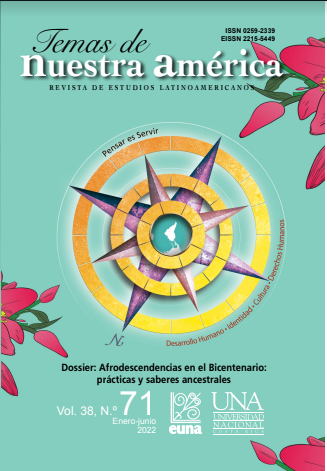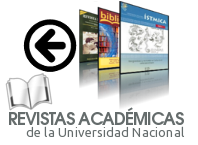Literature as an instrument of resistance and challenge to Central American power structures analyzed in the writings of Gerardo Maloney and Quince Duncan
DOI:
https://doi.org/10.15359/tdna.38-71.6Keywords:
Mental Slavery, alternative facts, African diaspore, Latin american studies, African cultural heritageAbstract
Our analysis of the works of Gerardo Maloney (1945) and Quince Duncan (1940) will show that they constitute the best instrument of resistance and defiance of the Central American power structures. In the first instance we will establish that that these power structures were put in place at the end of the eighteenth century by European ideologues who invented the “Aryan Model” . This is a theory that is based totally on “alternative facts” . It is the very foundation of Western civilization, the basis of White supremacy. The most perverse falsehood emanating from this system of alternative facts of the Aryan Model is the assertion that Africans were the last to develop literature. The Colombian writer of African descent, Manuel Zapata Olivella (1930-2005), took the first step to create a literary expression that authentically represented the immense cultural wealth of Spanish-speaking African descendants. Duncan by delving deeply into the religion and philosophy of Costa Ricans of African descent took the second step. Maloney’s art goes directly to the heart of the matter, celebrating the steps taken by those heroic activists dedicated to the resist and defy the power structures, and thereby achieve our liberation from mental slavery.
References
Aldeano, Algris Xiomara (2010). Bunde y bullerengue: Literatura oral popular de mi tierra, Darién. Washington, DC: Original World Press.
Allen, James P. (2014). Middle Egyptian: An Introduction to the Language and Culture of Hieroglyphs. 3rd Edition, Revised and Reorganized, with a New Analysis of the Verbal System. Cambridge: Cambridge University Press.
Bernal, Martin. (1987). Black Athena: The Afroasiatic Roots of Classical Civilization. Vol 1: The Fabrication of Ancient Greece 1785-1985. New Brunswick, N.J: Rutgers University Press.
Brathwaite, Edward Kamau. (1974). “The African Presence in Caribbean Literature.” Daedalus, 103, 73-109.
Cyrus, Stanley A. (1973). El cuento negrista sudamericano. Quito: Casa de la Cultura Ecuatoriana.
Diago Julio, Lázaro. (2011). Francisco el Hombre: Leyenda y Realidad. Bogotá: Grariq Editores.
Diop, Cheikh Anta. (1991). Civilization or Barbarism: An Authentic Anthropology. Trans. Yaa-Lengi Meema Ngemi. Eds Harold J. Salesmanson and Marjolijn de Jager. New York: Hill.
_____. (1974). The African Origin of Civilization: Myth or Reality. Ed. and trans. Mercer Cook. New York: Hill.
Duncan, Quince. (1979). Final de calle. 2nd ed. San José: Editorial Costa Rica.
_____. (1989). Kimbo. San José: Editorial Costa Rica.
_____. (1978). La paz del pueblo. San José: Editorial Costa Rica.
_____. (1976). La rebelión pocomía y otros relatos. San José: Editorial Costa Rica.
_____. (1973). Los cuatro espejos. San José: Editorial Costa Rica.
_____. (1970). Una canción en la madrugada. San José: Editorial Costa Rica.
Escalante, Aquiles. (1979). El Palenque de San Basilio: Una comunidad de descendientes de negros cimarrones. Barranquilla: Editorial Mejoras.
Estupiñán Bass, Nelson. (1966). El último río. Quito: Cultura Ecuatoriana.
Fanon, Frantz. (1963). Los condenados de la tierra. Traducción Julieta Campos. México: Fondo de Cultura Económica.
Friedemann, Nina S. de, y Carlos Patiño Rosselli. (1983). Lengua y sociedad en el Palenque de San Basilio. Bogotá: Caro y Cuervo.
García Márquez, Gabriel. (2007). Cien años de soledad. Edición Conmemorativa Real Academia Española Asociación de Academias de la Lengua Española.
Gates, Henry Louis, Jr. (1984). Editor. Black Literature & Literary Theory. New York: Methuen.
_____. (1988). The Signifying Monkey: A Theory of African-American Literary Criticism. New York: Oxford University Press.
Henderson, Stephen. (1973). Understanding the New Black Poetry: Black Speech & Black Music as Poetic References. New York: William Morrow.
Hilliard, Asa G., Larry Williams, and Nia Damali, eds. (1987). The Teachings of Ptahhotep: The Oldest Book in the World. Atlanta: Blackwood Press.
La Iliada / La Odisea. Madrid: EDIMAT, Clásicos Inolvidables.
Lyra, Carmen. (2000). Cuentos de mi Tía Panchita. San José: Editorial Costa Rica.
Llerena Villalobos, Rito. (1985). Memoria cultural en el vallenato: Un modelo de textualidad en la canción folklórica colombiana. Medellín: Centro de Investigaciones Facultad de Ciencias Humanas U. de A.
Maloney, Gerardo. (2008). Juega vivo. Washington DC: Original World Press.
_____. (2015). Cuentos étnicos. Panamá: Formato 16.
Prescott, Laurence E. (1985). Candelario Obeso y la iniciación de la poesía negra en Colombia. Bogotá: Instituto Caro y Cuervo.
Rodney, Walter. (1973). How Europe Underdeveloped Africa. Tanzania: Bogle L’Ouverture Publications.
Smart, Ian Isidore. (1996). Amazing Connections: Kemet to Hispanophone Africana Literature. Washington, DC: Original World Press.
_____. (2021). “Amo a mi raza”: Un enfoque afrocentrista sobre la literatura hispanoamericana. Washington, DC: Original World Press.
_____. (2017). Can African Americans Make America Great? Washington, DC: Original World Press.
_____. (1990). Nicolás Guillén, Popular Poet of the Caribbean. Columbia: University of Missouri Press.
_____. (2012). Occupying Western Civilization: Debunking the White Supremacist Narrative. Washington, DC: Original World Press.
_____. (2014). The Gunning Down of Michael Brown: An Afrocentric Response. Washington, DC: Original World Press.
_____. (2020). The Impeachment Can Make America Great. Washington, DC. Original World Press, 2020.
_____. con Kimani S. K. Nehusi, eds. (2000). Ah Come Back Home: Perspectives on the Trinidad and Tobago Carnival. Washington, DC: Original World Press.
_____ . (1985). “The Literary World of Quince Duncan: An Interview.” CLA Journal 28, 281-298.
Wilson, Carlos Guillermo “Cubena.” (1977). Cuentos del Negro Cubena; Guatemala: Landívar.
Zapata Olivella, Manuel. (1983) Changó, el gran putas. Bogotá: Oveja Negra, 1983.
_____. (1989). Las Claves Mágicas de América: Raza, Clase y Cultura. Bogotá: Plaza y Janes.
Published
How to Cite
Issue
Section
License
Esta obra de Revista Temas de Nuestra América está bajo una Licencia Creative Commons Atribución-NoComercial-SinDerivar 4.0 Internacional.
Cualquier permiso que trascienda dicha licencia, debe solicitarse por escrito a la persona directora de la Revista









